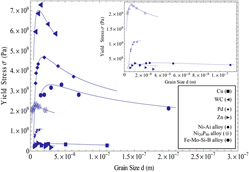Crossref Citations
This article has been cited by the following publications. This list is generated based on data provided by
Crossref.
Gutkin, M.Yu.
Enzevaee, C.
and
Shodja, H.M.
2013.
Interface effects on elastic behavior of an edge dislocation in a core–shell nanowire embedded to an infinite matrix.
International Journal of Solids and Structures,
Vol. 50,
Issue. 7-8,
p.
1177.
Frantziskonis, George N.
2013.
Multiscale unified prediction of size/scale and Hall-Petch effects in the mechanics of polycrystalline materials.
Journal of the Mechanical Behavior of Materials,
Vol. 22,
Issue. 1-2,
p.
67.
Chen, Xiang
Yang, Zhiqing
Sokolov, Mikhail A.
Erdman, Donald L.
Mo, Kun
and
Stubbins, James F.
2013.
Low cycle fatigue and creep-fatigue behavior of Ni-based alloy 230 at 850 °C.
Materials Science and Engineering: A,
Vol. 563,
Issue. ,
p.
152.
Yamanaka, Kenta
Mori, Manami
and
Chiba, Akihiko
2014.
Dynamic recrystallization of a biomedical Co–Cr–W-based alloy under hot deformation.
Materials Science and Engineering: A,
Vol. 592,
Issue. ,
p.
173.
Zhang, Xu
Aifantis, Katerina E.
Senger, Jochen
Weygand, Daniel
and
Zaiser, Michael
2014.
Internal length scale and grain boundary yield strength in gradient
models of polycrystal plasticity: How do they relate to the dislocation
microstructure?.
Journal of Materials Research,
Vol. 29,
Issue. 18,
p.
2116.
Aifantis, Elias C
2014.
Continuum nanomechanics for nanocrystalline and ultrafine grain materials.
IOP Conference Series: Materials Science and Engineering,
Vol. 63,
Issue. ,
p.
012129.
Zhang, X.
Romanov, A. E.
and
Aifantis, E. C.
2015.
A Simple Physically Based Phenomenological Model for the Strengthening/Softening Behavior of Nanotwinned Copper.
Journal of Applied Mechanics,
Vol. 82,
Issue. 12,
Zhang, X.
and
Aifantis, E. C.
2015.
Non-Monotonous Mechanical Behavior at the Nanoscale: Elastic and Plastic Properties.
Strength of Materials,
Vol. 47,
Issue. 4,
p.
642.
Cordero, Z. C.
Knight, B. E.
and
Schuh, C. A.
2016.
Six decades of the Hall–Petch effect – a survey of grain-size strengthening studies on pure metals.
International Materials Reviews,
Vol. 61,
Issue. 8,
p.
495.
Jia, Zhengmei
Liu, Yi
Wang, Yingying
Gong, Yongfeng
Jin, Peipeng
Suo, Xinkun
and
Li, Hua
2017.
Flame spray fabrication of polyethylene-Cu composite coatings with enwrapped structures: A new route for constructing antifouling layers.
Surface and Coatings Technology,
Vol. 309,
Issue. ,
p.
872.
Chen, Kaixuan
Pan, Shiwei
Zhu, Yuzhi
Cheng, Yongjian
Chen, Xiaohua
and
Wang, Zidong
2017.
In situ observations of crack propagation in as-cast Cu-1.5Fe-0.5Co (wt%) alloy.
Materials Science and Engineering: A,
Vol. 706,
Issue. ,
p.
211.
Aifantis, K. E.
Deng, H.
Shibata, H.
Tsurekawa, S.
Lejček, P.
and
Hackney, S. A.
2019.
Interpreting slip transmission through mechanically induced interface energies: a Fe–3%Si case study.
Journal of Materials Science,
Vol. 54,
Issue. 2,
p.
1831.
Zhao, Jianfeng
Kan, Qianhua
Zhou, Liucheng
Kang, Guozheng
Fan, Haidong
and
Zhang, Xu
2019.
Deformation mechanisms based constitutive modelling and strength-ductility mapping of gradient nano-grained materials.
Materials Science and Engineering: A,
Vol. 742,
Issue. ,
p.
400.
Fang, Lijia
Huang, Jing
Liu, Yi
Zhang, Botao
and
Li, Hua
2019.
Cored-wire arc spray fabrication of novel aluminium-copper coatings for anti-corrosion/fouling hybrid performances.
Surface and Coatings Technology,
Vol. 357,
Issue. ,
p.
794.
Wei, DeAn
Zaiser, Michael
Feng, Zhiqiang
Kang, Guozheng
Fan, Haidong
and
Zhang, Xu
2019.
Effects of twin boundary orientation on plasticity of bicrystalline copper micropillars: A discrete dislocation dynamics simulation study.
Acta Materialia,
Vol. 176,
Issue. ,
p.
289.
Kuhr, Bryan R.
and
Aifantis, Katerina E.
2019.
Interpreting the inverse Hall-Petch relationship and capturing segregation hardening by measuring the grain boundary yield stress through MD indentation.
Materials Science and Engineering: A,
Vol. 745,
Issue. ,
p.
107.
Naik, Sneha N.
and
Walley, Stephen M.
2020.
The Hall–Petch and inverse Hall–Petch relations and the hardness of nanocrystalline metals.
Journal of Materials Science,
Vol. 55,
Issue. 7,
p.
2661.
Mathaudhu, Suveen N.
2020.
Building on Gleiter: The Foundations and Future of Deformation Processing of Nanocrystalline Metals.
Metallurgical and Materials Transactions A,
Vol. 51,
Issue. 12,
p.
6020.
Ji, Weiming
and
Wu, Mao
2022.
Inhibiting the Inverse Hall-Petch Behavior in CoCuFeNiPd High-Entropy Alloys with Short-Range Ordering and Grain Boundary Segregation.
SSRN Electronic Journal ,
Wei, Fengxia
Cheng, Baisong
Chew, Li Tian
Lee, Jing Jun Coryl
Cheong, Kok Heng
Wu, Jiang
Zhu, Qiang
and
Tan Cheng Cheh, Dennis
2022.
Grain Distribution Characteristics and Effect of Diverse Size Distribution on the Hall-Petch Relationship for Additively Manufactured Metal Alloys.
SSRN Electronic Journal ,





